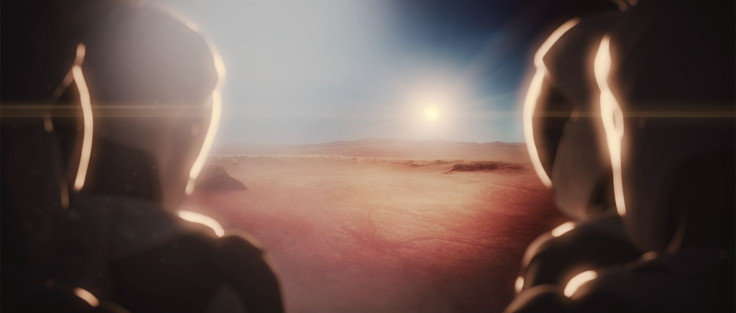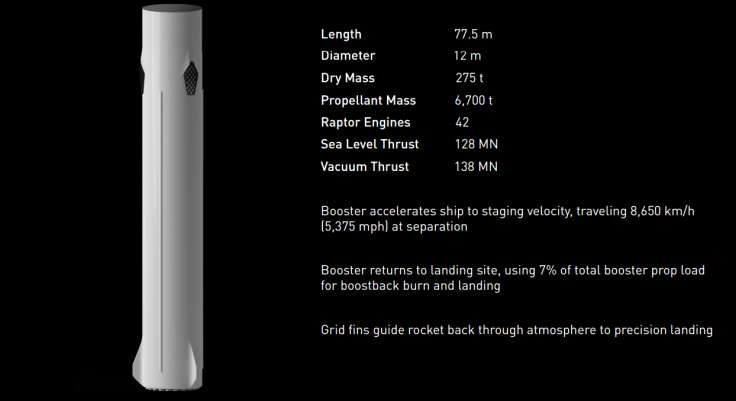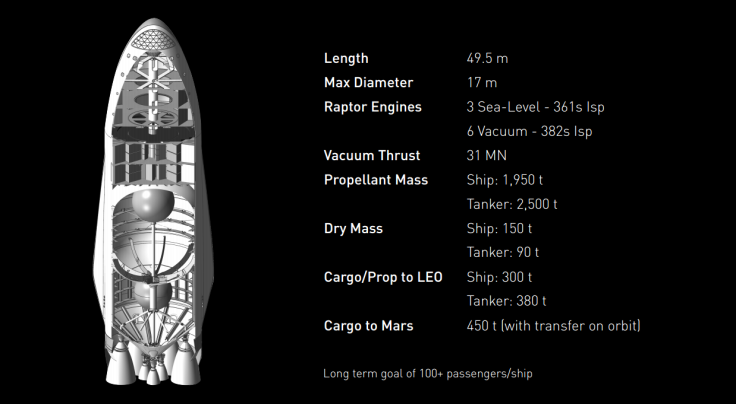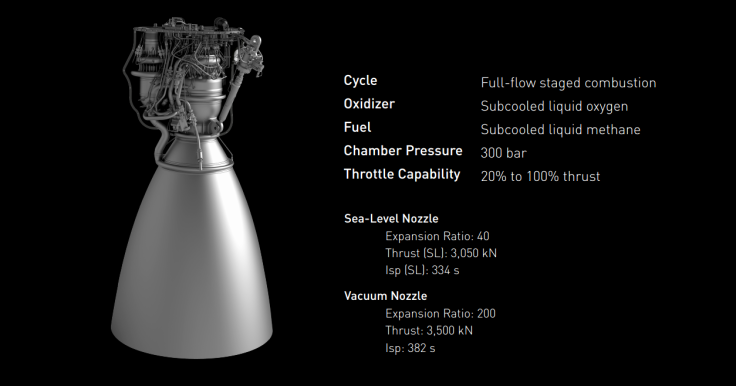Elon Musk’s Mars Colonization Plans: What Is Interplanetary Transport System And How Would It Get Us To The Red Planet?

“We have lingered long enough on the shores of the cosmic ocean. We are ready at last to set sail for the stars,” Carl Sagan once famously said. On Tuesday, SpaceX CEO Elon Musk outlined his plans for the first step toward realizing this grandiose vision — getting humans to Mars.
“Someday soon , there will be an extinction event on Earth,” Musk said during his keynote speech at the International Astronautical Congress in Guadalajara, Mexico. If we are to avoid the fate that befell more than 99 percent of the species that ever lived on this planet, the solution, according to Musk, “is to become a spacefaring civilization, and a multi-planetary species.”
In order to achieve the highly-ambitious goal of creating self-sustaining human colonies on the red planet in the next 50 to 100 years, what is needed is a ridiculously large spaceship sitting atop a ridiculously massive rocket, boosted by engines that are as ridiculously powerful.
And these are exactly the things Musk provided details about during his hour-long presentation on SpaceX’s “Interplanetary Transport System.”
The Rocket:
The Interplanetary Transport System (ITS) rocket that would power the “Mars Vehicle” would be a scaled up version of SpaceX’s 70 meter (230 feet) tall Falcon 9. Much like the Falcon 9, which the company has already tested several times, the 77.5-meter tall ITS rocket would be reusable, and would act as a “javelin” for the spaceship.

The Spaceship:
Unlike the cramped quarters of the Apollo-era spaceships, the spaceship that will take the first humans to Mars will have enough space for at least 100 people, and even movie theaters, lecture halls and a restaurant.
“It'll be, like, really fun to go,” Musk said. “You'll have a great time.”
The first ship to go to Mars may even be named “Heart of Gold” — a tribute to the ship in “Hitchhiker’s Guide to the Galaxy” which was powered by the “infinite improbability drive” and stolen by the galactic president Zaphod Beeblebrox during its inauguration.
A prototype of the spaceship is expected to begin test flights in four years.
The Mars Vehicle, including the booster and the spaceship, would be a staggering 122 meters in height, making it the largest spaceflight system ever built — even bigger than the 111-metre tall Saturn V rocket used by NASA during its Apollo-era space program.

The Engines:
The ITS booster will be powered by 42 raptor engines arranged in two concentric circles, and the spaceship would be equipped with another 9. The raptor engine, which SpaceX tested just a few days ago, will be powered by liquid methane and oxygen, and is expected to be three times more powerful than the Merlin engines that currently power SpaceX’s Falcon 9 and Falcon Heavy rockets.
The powerful engines would allow the spaceship to carry 450 tons of payload, including at least 100 people. And, depending on the relative positions of Earth and Mars, the journey may be completed in as little as 80 days. Currently, it takes roughly eight months to send to send a spacecraft to Mars.
Once the spaceship reaches Mars, the engines would fire in order to accomplish what SpaceX has previously called “supersonic retropropulsion” needed to land the craft vertically on the surface.

The Plan:
The Mars Vehicle, with very little fuel on board, would lift-off from NASA’s Kennedy Space Centre pad 39. Once it places the spaceship in orbit around Earth, the booster would decouple and come back down to land vertically on a launchpad. Then, it would lift-off again, carrying a fuel tank that would refuel the spaceship in orbit.
Once the ITS is up and running, Musk envisioned that a fleet of spaceships — each carrying at least 100 people — would lift off every 26 months, when Mars is closest to Earth. If all goes according to plan, the first Mars flight could take place as early as 2022 and, in the next 100 years, one million people could be living on what is currently a barren and hostile world.
More importantly, this would not be a one-way trip. The plan is to refuel the ITS spaceships on Mars itself, using carbon dioxide and ice on the Martian surface to create the methane and oxygen need to fuel its engines.
“We need the spaceship back, so it's coming,” Musk said. “You can jump on board or not.”

And how would this venture be funded?
Musk suggested there were two possible revenue streams — launching satellites, and sending cargo and astronauts to the International Space Station. And a third one, Musk said via Twitter: “steal underpants” — a reference to a “South Park” episode.
Funding:
— SpaceX (@SpaceX) September 27, 2016
Steal Underpants ✓
Launch Satellites ✓
Send Cargo and Astronauts to ISS ✓
Kickstarter ✓
Profit ✓https://t.co/kCtBLPbSg8
“The reason I am personally accruing assets is to fund this,” Musk said. “I really have no other purpose than to make life interplanetary.”
Musk estimated that the current cost of sending people to Mars is roughly $10 billion per person. However, the reusability of the ITS booster would allow the cost to come down to less than $200,000.
“What I really want to try to achieve here is to make Mars seem possible — like it’s something we can achieve in our lifetimes,” Musk said. “Without someone with a real ideological commitment, it didn't seem we were on any trajectory to become a spacefaring civilization.”
NASA, which also has an ambitious plan to send humans to Mars sometime in the 2030s, and would be closely watching SpaceX’s planned Red Dragon Missions, welcomed Musk’s plans, calling the discussion about colonizing the planet “very encouraging.”
“NASA applauds all those who want to take the next giant leap — and advance the journey to Mars. We are very pleased that the global community is working to meet the challenges of a sustainable human presence on Mars,” the space agency said.
© Copyright IBTimes 2024. All rights reserved.












